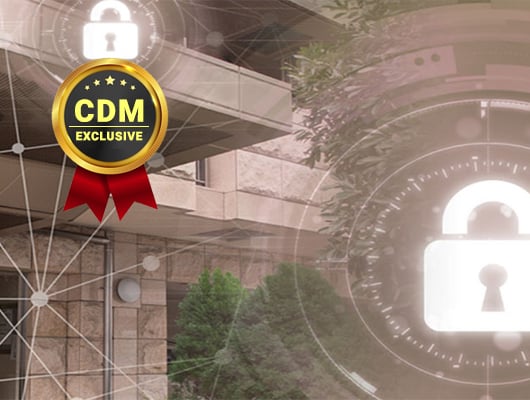- 속속 등장하는 AI 보안 도구··· 전문가들 “기존 방화벽 곧 업그레이드 필요”
- The IT Review That Saved Lives: How Lumus Imaging CIO Got It Right
- 기업 92%가 ‘생성형 AI 역량’ 필요한 직무 채용 준비 중
- I've yet to find a retro stereo amp that delivers sound as accurately for various genres than this
- Use AI at work? You might be ruining your reputation, a new study finds
Video Intercom Systems Reinvent Building Security – Cyber Defense Magazine

By Melvin Braide, Content Writer
Intercom systems have been around for decades, but recently access control solutions have started to incorporate video functionality, surveillance, and two-way calling. In this piece, we discuss how video intercom is reinventing residential and commercial building security.
An intercom system is an autonomous, internal communication system within a building or a collection of buildings that is not part of the public telephone network. It is a familiar presence in offices, multi-tenant buildings, and some homes. In its most primitive stage, it was nicknamed the “buzzer” – because of the sound it made when a guest pushed the button at the front door of a multi-tenant building – and letting a visitor into the building was “buzzing them in.” Those systems linger in older facilities.
The buzzer system offered adequate, if not clear, audio. Over time, the frailties of this technology became apparent. You could hear the guest’s voice, but you couldn’t completely verify identification. Simply put, you couldn’t visually assess who you are allowing onto your premises. That changed with video intercoms.
What Is a Video Intercom System?
Holistic safety and security in today’s post-COVID society include cybersecurity, physical security, and environmental health and safety. An ideal system would address security on all three fronts. A video intercom is one such tool. So what is it?
A video intercom is an advanced intercom system with a video component that supports two-way video calls. The video component allows you to assess anyone at the front door before granting access. High-end video intercoms combine with cloud-based systems to connect mobile devices for remote visitor management and access control.
How Is Video Intercom Being Used in Commercial and Residential Buildings??
Video intercom systems are increasingly employed to strengthen security and improve visitor management. The versatility of video intercom systems makes them suitable for both residential and commercial facilities. But there are subtle differences in how they are used in different situations.
- Office intercom systems: Intercom systems for businesses are used for more extensive purposes than just granting access to visitors. Office video intercom systems serve as an internal communication system between offices in the same building and different locations.
- Video intercom systems for multi-tenant commercial buildings: High-rise multi-tenant buildings use video intercom primarily to verify a visitor’s identity. In this sense, a visitor also includes couriers, maintenance personnel, and employees missing their access credentials.
- Residential video intercom: For apartment complexes and condominium communities, the primary concern is to protect against theft, break-ins, and vandalism and monitor access to the building when you’re not home.
Regardless of the utility, it’s important to choose the right video intercom system. Video intercom systems come with a variety of features that serve various purposes. You can opt for a wireless video intercom and connect via WIFI, or you can choose a wired system that connects with ethernet.
Benefits of Video Intercom Solutions
Visitor identification via video increases security
Video intercom adds an extra layer of protection to your residential or office security system. Its standout feature is the two-way video call that allows you to verify who you are talking to and whether they are alone. Some video intercoms use up to a 7MP high-resolution camera capable of capturing the tiny inscriptions on an ID card for verification.
Touchless/hands-free solutions
A video intercom with access control capabilities increases physical health in this COVID world. Integrated system capabilities can be connected to any electronic door unlock system preinstalled in your building. With that in place, after confirming the identity of the person at the front door, you can grant access remotely to align with current social distancing guidelines. It’s completely contactless; hence, no health fears.
Cloud-based solutions
We come in contact with cloud-based solutions every day. Cloud capabilities have long surpassed networks for many reasons. The benefits of cloud-based access control mirror the secure and resilient nature that make the solution so attractive. COVID-19 has exacerbated the utility of on-premise systems, so the security industry is shifting to put systems management back into the hands of the experts.
Remote access control and visitor management
With remote visitor management, it’s possible to remain a healthy distance away from others while granting or denying access from anywhere. Many times, especially in today’s environment, it’s not possible to physically welcome a visitor. So, remote capabilities are now becoming an essential feature when it comes to building a sound facility operation.
Accountability
Accountability has been a security component, but never has it been so pronounced as it is today. Advanced visitor management systems have the ability to capture data that hasn’t been possible before. With the help of video intercom, it’s possible to review who is in the building, for what reason, and for whom. This is incredibly useful in the event of an emergency or should an incident occur within the facility, where the facility manager is the one held accountable.
About the Author
Melvin Braide is a professional content writer and copywriter at Swiftlane, with a degree in Mechanical Engineering and years of experience writing across various niches. Melvin focuses on providing valuable and educational content for Swiftlane’s growing audience in the areas of access control, visitor management, and security.


